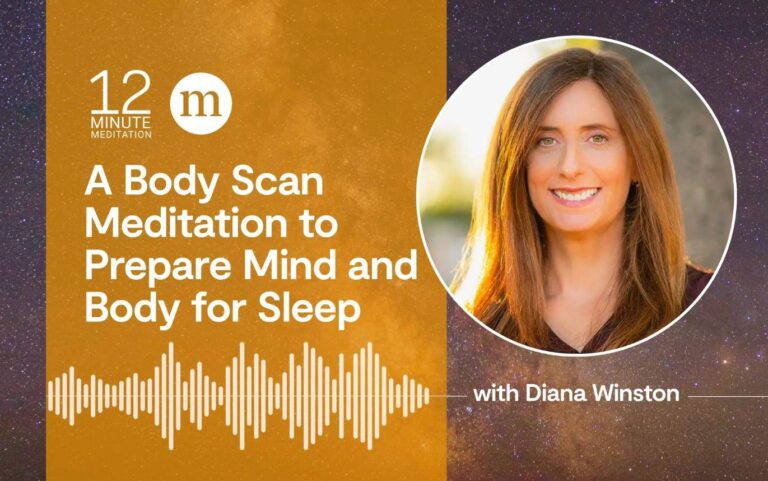“`html
Overview
What Is Body Scan Meditation? It’s a guided exercise that focuses attention on various body parts to alleviate tension and enhance awareness.
Benefits for Better Sleep:
- Enhances sleep quality, particularly for those experiencing sleep issues.
- Reduces physical strain that may hinder falling asleep.
- Soothes the nervous system and lowers stress levels.
- Assists in disconnecting from mental chatter that keeps the mind active.
Research Insights: Studies from UCLA indicate that mindfulness meditation can enhance sleep quality for older adults with sleep problems.
How to Use It: You can practice this while lying in bed, making it easier to transition from wakefulness to rest.
The Science Behind Improved Sleep through Mindfulness
A restful night is crucial for our well-being, helping us feel more energized, less anxious, and more mentally alert. Unfortunately, a survey conducted in 2024 revealed that many struggle with insomnia, with 57% of Americans indicating that they would feel better if they had more sleep.
If you often find yourself awake at 3 a.m., pondering the shadows on your ceiling, embracing mindfulness might be your solution for better sleep. A randomized clinical trial by UCLA showed that mindfulness meditation can significantly enhance sleep quality for older adults facing sleep disruptions. Here’s a guided meditation from that study, which may help you as well.
We will observe sensations without attempting to alter them, simply bringing mindful attention and curiosity to the present moment.
During the guided body scan meditation, you may drift off to sleep. That’s perfectly fine, so allow the meditation to end naturally. If worries or distractions arise, recognize that it’s normal, and try to gently refocus on the body scan.
If you can, notice your body lying on the bed and observe any sensations present—such as vibrations, tingling, heaviness, or temperature. Approach these sensations with mindful curiosity, letting go of any judgments or thoughts that arise, and simply return your focus to the sensations in your body.
A Body Scan Meditation for Achieving Rest
1. Start by tuning in to the sensations at the top of your head. Just take note of what you feel—perhaps vibrations or pressure.
2. Focus on your skull where it rests on the bed or pillow. Be attentive to any sensations like pressure.
3. As best as you can, let go of any tension. If you find it hard to release, just acknowledge the feeling.
4. Move your attention to your face, including your forehead, eyes, and nose. Be aware of your cheeks and mouth, noting any sensations of tightness or temperature. Observe the sensations in your throat.
5. Focus on the area around your shoulders. Be aware of any tension present. Sometimes simply noticing tension can lead to relaxation. If not, gently breathe into your shoulders to ease tension.
6. Shift your focus to your left shoulder, then travel down your arm. Observe sensations in your elbow, lower arm, and hand. Approach the feelings in your hands and fingers with curiosity, allowing them to relax.
7. Now move your focus to your right shoulder, and scan down your right arm for sensations. Pay attention to your elbow, forearm, and hands. If there are moments of no sensation, just acknowledge that too.
8. Direct your attention to your shoulders and back. Imagine a zigzag feeling or an up-and-down sensation across your back, being open to whatever you experience. Be gentle with yourself, regardless of what arises.
9. Notice your upper, middle, and lower back sensations. If distracting thoughts occur, see if you can release them, imagining them as clouds drifting by. Alternatively, return your focus to the instructions and the body scan.
10. Attend to your chest area. Gently scan your chest, rib cage, and stomach, allowing your stomach to soften as you breathe deeply into that space.
11. Now turn your attention to your pelvic area and how your body connects with the bed. Feel any sensations, then move your focus to your left hip and down your left leg, observing feelings in your thigh.
12. Apply this curious attention to your knee and left calf, noting any sensations—whether vibrations, tingling, warmth, or heaviness. Continue down to your ankle, left foot, and toes.
13. Next, focus on your right hip, and move your attention down your right thigh. You can rotate your focus around your right leg or approach it in a way that feels right for you. Acknowledge any vibrations, tingling, heaviness, or movement in your knee and calf, and continue down to your right ankle and toes.
14. Having completed your body scan, feel free to repeat the process, starting from your feet and moving up to your head, as many times as suits you.
The Ultimate Guide to Mindfulness for Sleep
Adequate sleep rejuvenates our bodies and minds, yet many find it elusive. Mindfulness practices can facilitate falling and staying asleep. Explore our guide for tips on meditation, movement, and mindfulness practices to promote sleep.
Read More
“`


